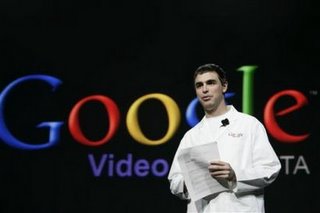
No longer is the cellular phone selection limited to the RAZR, a $500 Treo and hundreds of look-alikes and act-alikes. Recent months have brought a wave of new devices that stand apart from the pack in terms of looks and next-generation features.
Dominating the new crop is a widening array of BlackBerry-like "smart" phones designed to be more consumer-friendly in function and price. As compared with the $300 to $500 traditional price tag for higher-end devices, these handsets are debuting at $200 with a two-year contract.
More than ever, thin is also in, with the carriers offering a growing number of slenderized clamshell and candy-bar phones. Yet despite the shrinking size, phones are coming with more built-in bells and whistles: external memory slots for storing music and photos, higher-resolution cameras and high-speed Internet capabilities.
A sampling of notable new handsets:
BlackBerry Pearl from T-Mobile and Cingular Wireless
The first BlackBerry targeting the consumer market, the Pearl is the first with a digital camera (1.3 megapixels), an MP3 music player and a memory slot. Just 2-inches wide and weighing 3.2 ounces, the Pearl's narrow QWERTY keyboard features two letters per key, relying on predictive software to suggest and choose the desired letter. A glowing navigational trackball — dubbed the Pearl — on the front replaces the signature side track wheel on other BlackBerry models. ($349.99 to $399.99 list price, depending on carrier, $199.99 with contract commitments and rebates)
LG "enV" from Verizon Wireless
The enV, also called the VX 9900, is a slimmer and lighter upgrade to the "V," a clamshell that opens to reveal a spacious QWERTY keyboard and dual speakers on the sides of a wide screen. Though a smidge longer and wider than the V, the enV is almost a quarter-inch thinner at 0.78 inch deep and half an ounce lighter at 4.6 ounces. The enV also features GPS satellite navigation and a higher-resolution 2 megapixel camera. ($319.99 list price, $129.99 with two-year agreement and $50 rebate)
___
Nokia E62 from Cingular Wireless
The E62 is the first mass-market smart phone based on the Symbian operating system offered in the United States. There's a heavy focus on e-mail through multiple applications. It also features a full-QWERTY keyboard and an external memory slot, but no camera. The E62 is "quad-band" compatible with four common wireless frequencies for overseas roaming. ($349.99 list price, $99.99 with two-year contract and rebate)
Motorola KRZR K1m from Verizon Wireless, Sprint and Alltel
An offshoot of the sleek RAZR line, the KRZR is a third of an inch smaller from side to side compared with its famous cousin, though a tad thicker, taller and heavier. Unlike the RAZR, the KRZR features external music controls. The version of this handset currently available in the United States also features a 1.3 megapixel camera, a memory slot and GPS location tracking. A version sold overseas and expected to be offered by other U.S. carriers next year has a 2 megapixel camera. ($349.99 to $399.99 list price, depending on the carrier, $199.99 to $249.99 with contract commitments and rebates)
___
Motorola ic502 from Nextel
The first dual-network phone since the merger of Sprint and Nextel, the ic502 offers Nextel subscribers decent wireless Internet speeds for the first time using Sprint's network. It also provides access to Nextel's hugely popular walkie-talkie services. The GPS-enabled handset is built to military specifications to withstand rugged conditions. While it doesn't sport a camera and other consumer-ish features, the higher data bandwidth is a major upgrade from the sub-dialup speed of other Nextel phones. ($249.99 list price, $59.99 with mail-in rebate and two-year contract)
___
Palm Treo 680 from Cingular Wireless
The first Treo targeting the consumer market, the 680 is slightly slimmer in size and far more slender in price than its predecessors. This QWERTY-keyboard device runs on the Palm platform and features a new 5-button "quick launch" toolbar on the touch screen. An ounce lighter than the pricier Treo 700, other physical distinctions include an internal antenna and a memory slot on the side. On the downside, the 680 has a lower-resolution camera and doesn't connect with Cingular's speedier data network. ($449.99 list price, $199.99 with two-year contract and rebate)
___
Samsung BlackJack from Cingular Wireless
A small and sleek handset packed with high-end features, the Windows-based BlackJack is less than half an inch thick and weighs 3.5 ounces. Features include high-speed "3G" Internet access and a choice of navigation with either a front four-way key or a thumb wheel on the side. There's also a full-QWERTY keyboard,1.3 megapixel camera and external memory slot. It's quad-band compatible with four common wireless frequencies for overseas roaming. ($449.99 list price, $199.99 with two-year contract and rebate)
___
Samsung M610 from Sprint
Billed as the thinnest clamshell phone in the United States, the M610 is just 0.47 inch thick, or about a tenth of an inch thinner than the RAZR. It's also about a fifth of an ounce lighter at 3.28 ounces. Perhaps more importantly, it connects with Sprint's broadband-speed Power Vision network. Other features include a 2 megapixel camera, external memory slot and GPS location tracking. ($329.99 list price, $179.99 with two-year contract)
___
Samsung Trace from T-Mobile
At just 0.3 inch thick, the Trace is a new slimness champ among "candy bar" (non-flip) phones. Despite the small size and weight — 2.5 ounces — the phone offers an unusually large screen and multimedia features: 1.3 megapixel camera, MP3 music player and external memory slot for storing pictures and music. ($199.99 list price, $99.99 with two-year contract)
___
Sidekick 3 from T-Mobile
The newest addition to the popular Sidekick family is about 20 percent smaller than its predecessor and features a new trackball for one-handed navigation. Other improvements on the SideKick 2 include the addition of an MP3 player, external memory slot, and a removable battery. ($479.99 list price, $249.99 with two-year contract)
___
T-Mobile Dash
A cellular and Wi-Fi smart phone running on Windows Mobile. Features include a full-QWERTY keyboard, 1.3 megapixel camera, external memory slot, Windows Media Player Mobile. The phone also offers quad-band compatibility with four common wireless frequencies for overseas roaming, and an internal Wi-Fi antenna to connect to the Internet over a home or public wireless network (such as T-Mobile Hotspots at Starbucks and other retail locations). ($349.99 list price, $199 with a two-year contract)





